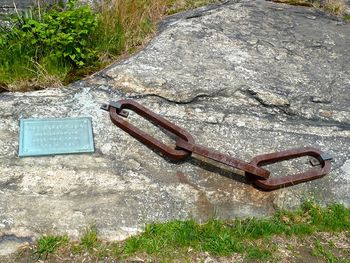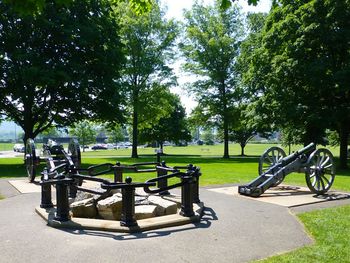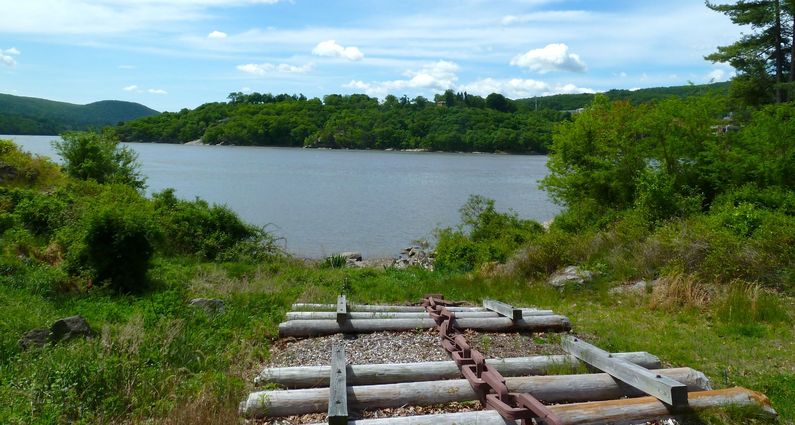Great Chain - West Point
|
The Great Chain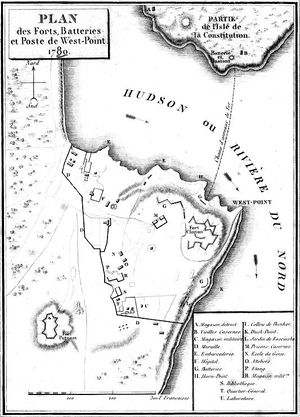 A 500 yard long iron chain built for Patriot forces during the Revolutionary War to block British ships from sailing up the Hudson River to Albany. Had the British been able navigate the full length of the Hudson they could have cut the Colonies in two. The "Great Chain" was placed between West Point and Constitution Island at a point where the Hudson River makes an "S" curve and sailing ships were force to slow down and tack, making them vulnerable to shore batteries. In conjunction with the placement of the chain, a series of fortifications were established at both the West Point end and on the Constitution Island end of the chain. Collectively these fortifications came to be known as Fortress West Point. While the goal was to stop British ships from controlling the Hudson, the chain was considered the key element in the defense and many of the fortifications directly protected the chain. The chain itself was fastened on the West Point side of the river at what became known as Chain Cove and directly protected there by Chain Battery, Battery Lanthorn and from the plain above by Fort Arnold, later renamed Fort Clinton after Benedict Arnold's treachery was discovered. The southern river approaches to the chain were covered by Water Battery, South Battery and Fort Clinton. The chain was fastened on Constitution Island at a southwest inlet and protected there by a series of batteries including Romans Battery, Marine Battery, Hill Cliff Battery and Gravel Hill Battery. All of the river facing gun batteries were protected from land side attack by a ring of forts, redoubts and support batteries. The chain was first connected across the river on 30 April 1778 under the direction of Captain Thomas Machin. The first year a parallel log boom was also deployed 300 feet south of the chain as a buffer but it suffered from rot and was discontinued in subsequent years. From 1778 until 1783 the chain was disconnected in the late fall, refurbished over the winter with new log booms and reconnected in the spring when river ice was no longer a threat. The chain was not deployed in the spring of 1783 signalling to all that the war was at an end.
Building The Chain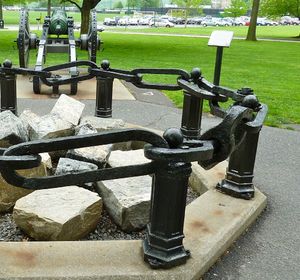 On 2 Feb 1778 Colonel Hugh Hughes, Deputy Quartermaster-General, contracted with Peter Townsend of Noble, Townsend and Company, proprietors of the Stirling Iron Works, Warwick, New York, to produce the chain at a cost of about four hundred and forty pounds per ton with a delivery date of 1 Apr 1778. Captain Thomas Machin had established all the specifications and requirements but it was Hughes who did the contract. This was a massive order for the time and Machin asked the company to "to keep seven fires at forging and ten at welding” 24 hours a day to complete the order within the approximately eight week timeframe. The chain was to be about 500 yards long composed of two-foot links each weighing an average of 114 pounds each. A swivel was to be inserted every 100 feet and a clevis inserted for every 1,000 pounds of chain. Sources differ as to what was actually delivered and in fact it appears that the links delivered varied greatly in length and weight. The chain links were assembled into sections each with a clevis on one end so the sections could be connected and disconnected. It appears that there were about 54 of these sections connected together to make up the chain. Each section of chain was stapled to a log raft that contained four large logs. Each section weighed about 1300 pounds and carried about 30' of the chain. Each log raft was sufficient to float one section of the chain. The sets were assembled at New Windsor about nine miles north of West Point, and floated downstream to Moore's House for final assembly. The assembled chain was brought into the two anchor locations with large capstans built especially for the task. When fully emplaced the chain was probably anchored to large log cribs filled with rock. Long after the end of the war the sections were sold for scrap in 1829 with only a couple of sections retained for posterity. One of the saved sections is on display at Trophy Point on the United States Military Academy and it appears to be a complete set with both a clevis and a swivel on one end and twelve connected links. This section was put on display in 1857. It seems unlikely that anyone would have modified this historic artifact so it is probably our best example of what a chain section actually looked like. The West Point display links weigh an average of 114 pounds with the heaviest being 130 pounds. The length varies from 28" to 36" with the average being 31.5". A reconstruction of the chain and the log rafts is located across the river on Constitution Island but it is unclear how accurate the reconstruction is because the rafts only have three relatively short logs and no clevis between the sections.
See Also: Sources:
Links: | ||||||||||||||||||||||||||||||||||||||||||
